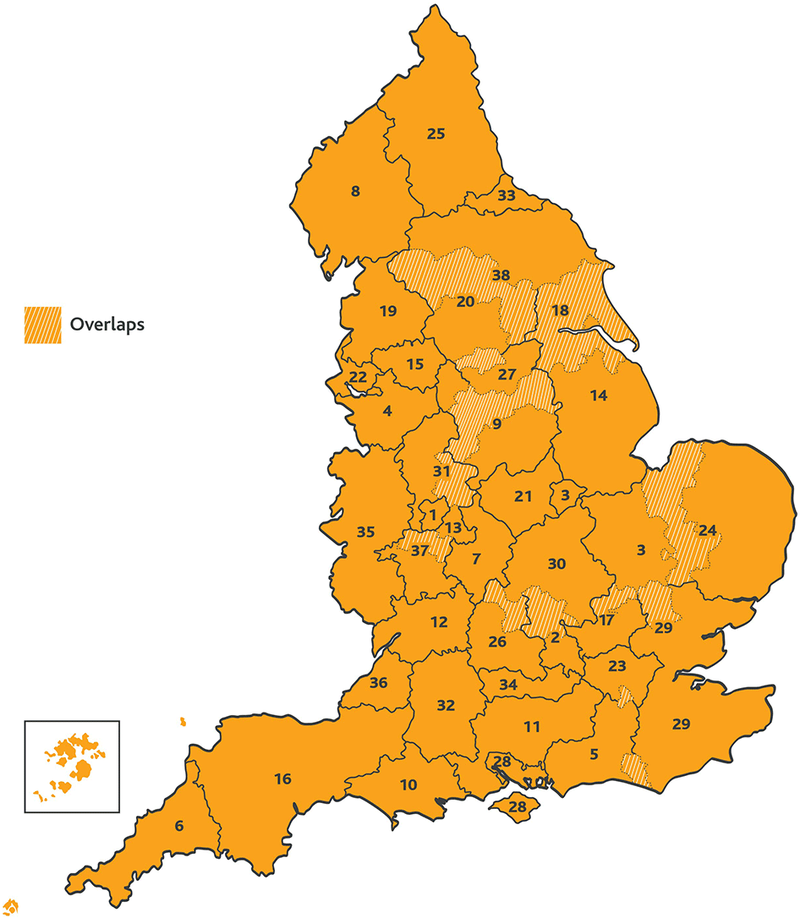Local Enterprise Partnerships: Difference between revisions
New page |
No edit summary |
||
| (2 intermediate revisions by one other user not shown) | |||
| Line 1: | Line 1: | ||
[[Category: | [[Category:Non-Governmental Organisation]] | ||
Local Enterprise Partnerships (LEPs) are business led partnerships between Local Authorities and local private sector businesses. There are currently 38 across England. | Local Enterprise Partnerships (LEPs) are business led partnerships between Local Authorities and local private sector businesses. There are currently 38 across England. | ||
| Line 6: | Line 6: | ||
The Strengthened Local Enterprise Partnerships Review by the [[Ministry of Housing, Communities and Local Government]] published in 2018 set out the enhanced role of LEPs in driving local growth and how government and LEPs will work together to strengthen leadership and capability, improve accountability and manage risk. It also sought to ensure that all businesses and communities are represented by one LEP. | The Strengthened Local Enterprise Partnerships Review by the [[Ministry of Housing, Communities and Local Government]] published in 2018 set out the enhanced role of LEPs in driving local growth and how government and LEPs will work together to strengthen leadership and capability, improve accountability and manage risk. It also sought to ensure that all businesses and communities are represented by one LEP. | ||
The map below shows the 38 LEPs currently in operation across England. | The map<ref name="LEP" /> below shows the 38 LEPs currently in operation across England. | ||
[[File:LEP map.png|800px|right|LEP Regions]] | |||
#Black Country | |||
#Buckinghamshire | |||
#Cambridgeshire & Peterborough | |||
#Cheshire & Warrington | |||
#Coast to Capital | |||
#Cornwall and Isles of Scilly | |||
#Coventry and Warwickshire | |||
#Cumbria | |||
#Derby, Derbyshire, Nottingham, Nottinghamshire | |||
#Dorset | |||
#Enterprise M3 | |||
#GFirst | |||
#Greater Birmingham & Solihull | |||
#Greater Lincolnshire | |||
#Greater Manchester | |||
#Heart of the South West | |||
#Hertfordshire | |||
#Humber | |||
#Lancashire | |||
#Leeds City Region | |||
#Leicester & Leicestershire | |||
#Liverpool City Region | |||
#London | |||
#New Anglia | |||
#North East | |||
#Oxfordshire | |||
#Sheffield City Region | |||
#Solent | |||
#South East | |||
#South East Midlands | |||
#Stoke-on-Trent and Staffordshire | |||
#Swindon and Wiltshire | |||
#Tees Valley | |||
#Thames Valley Berkshire | |||
#The Marches | |||
#West of England | |||
#Worcestershire | |||
#York, North Yorkshire and East Riding | |||
==References== | |||
<references /> | |||
Latest revision as of 14:02, 23 April 2020
Local Enterprise Partnerships (LEPs) are business led partnerships between Local Authorities and local private sector businesses. There are currently 38 across England.
They play a central role in determining local economic priorities and undertaking activities to drive economic growth and job creation, improve infrastructure and raise workforce skills within the local area. LEP boards are led by a business Chair and board members are local leaders of industry (including SMEs), educational institutions and the public sector.[1]
The Strengthened Local Enterprise Partnerships Review by the Ministry of Housing, Communities and Local Government published in 2018 set out the enhanced role of LEPs in driving local growth and how government and LEPs will work together to strengthen leadership and capability, improve accountability and manage risk. It also sought to ensure that all businesses and communities are represented by one LEP.
The map[1] below shows the 38 LEPs currently in operation across England.

- Black Country
- Buckinghamshire
- Cambridgeshire & Peterborough
- Cheshire & Warrington
- Coast to Capital
- Cornwall and Isles of Scilly
- Coventry and Warwickshire
- Cumbria
- Derby, Derbyshire, Nottingham, Nottinghamshire
- Dorset
- Enterprise M3
- GFirst
- Greater Birmingham & Solihull
- Greater Lincolnshire
- Greater Manchester
- Heart of the South West
- Hertfordshire
- Humber
- Lancashire
- Leeds City Region
- Leicester & Leicestershire
- Liverpool City Region
- London
- New Anglia
- North East
- Oxfordshire
- Sheffield City Region
- Solent
- South East
- South East Midlands
- Stoke-on-Trent and Staffordshire
- Swindon and Wiltshire
- Tees Valley
- Thames Valley Berkshire
- The Marches
- West of England
- Worcestershire
- York, North Yorkshire and East Riding
